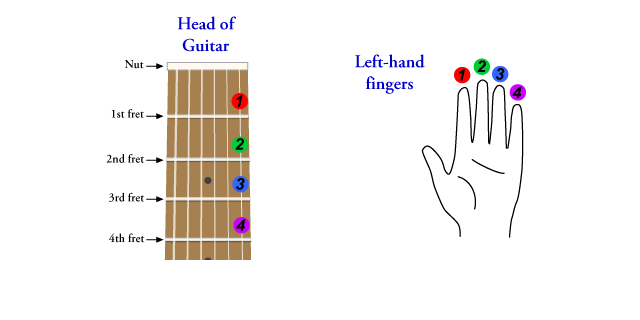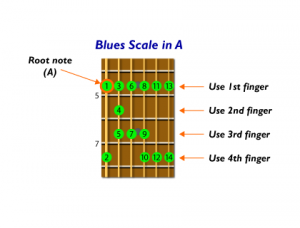How to Play Guitar Scales for Beginners
This post will teach you how to play basic guitar scales.
Why You Should Learn How To Play Guitar Scales
Scales are a basic building block of music for all instrumentalists, singers, composers and those who want to improvise and play solos (as when playing lead guitar).
What makes a scale?
A scale (from the Italian word scala, meaning ladder) is a series of notes, either ascending or descending, with a particular interval between each successive note. Intervals indicate the distance between two pitches. Guitarists might think of this as the number of frets between notes. For example a whole step (W) is when two notes are two frets apart, and half steps (1/2) are when two notes are one fret apart. There are several different types of scales. Each scale has a distinct sound because of its unique arrangement of intervals. Here we will cover the most commonly used scales and the most commonly used positions of these scales. We will cover major and minor scales as well as the major pentatonic (country), minor pentatonic (rock) and blues scales.
Scale Types
The major and minor scales are based on modes. The seven modes are scales of an earlier origin, some of which are used today. We will focus on the most commonly used modes — Ionian, which is our major scale, and Aeolian, which is our natural minor scale. The pentatonic and blues scales are unique scales widely used in today’s music.
Scale Fingerings
There are two main scale fingerings, open and closed/moveable. Open scales include the use of open string. Closed, or moveable fingerings use no open strings. Closed scales, because they use no open strings, are movable — you can move them from one position to another to create the same scale in a new key. Also, if you use that same closed, moveable fingering you can create new scales by starting on a different scale step. For example, a closed fingering of a G major scale becomes an A major scale when the same fingering is played two frets higher. Also an A major closed fingering can be used to play a B dorian “mode” (a special type of scale) by simply starting the scale on the second step (the B note) instead of the A note. Although there is no hard and fast rule, different musical styles tend to rely more on one type of fingering than the other. For example, rock guitarists use more closed scales, whereas folk and bluegrass guitarists use more open scales.
Fingering System for Guitar Notes
Scale fingering diagrams will use numbers to indicate what fingers to use when playing the notes. 
A graphic to show how left-hand fingerings are marked for reading guitar notes.
Remember to try and use the one-finger-per-fret rule when playing guitar notes. This will make playing the notes easier and help you develop great basic guitar technique. One-finger-per-fret means that wherever you place your hand on the guitar fingerboard, each finger will cover the notes sequentially up and down the fingerboard. As in the example above, you can see that the first finger would play all the notes found the first fret for all the strings; the second takes all the notes on the second fret; etc. If the first finger was on the third fret, then then the second would play all the notes on the fourth fret, the third finger all the notes on the fifth fret, etc.
Hand and Finger Position When Learning How to Play a Guitar Scale
When learning how to play guitar scale, it is crucial to concentrate on your guitar playing technique. Good single note technique includes:
- Keep your left-hand fingers curved
- Play on your fingertips, as seen in this video
- Play the guitar scale both going up and going down
- When going up the scale, do not take your finger off of a note, until your finger is placed on the next note up on that same string
- When going down the scale, have your finger covering the next lower note before you lift your finger from the higher note on the same string
- Play using alternate picking
- Aim for an even sound and smooth rhythm
The Major Scale
Here is a diagram that shows you how to play a major scale on guitar in the key of A major. It is a moveable scale shape, with the root being played by your first (1st) finger.
The Minor Pentatonic Scale
Here is a diagram that shows you how to play the pentatonic scale on guitar. It is on of the most common scales for rock guitar and other music styles that use power chords and/or minor chords.
The Major Pentatonic Scale
This diagram shows how to play the major pentatonic scale on the guitar in the key of A major. It is a moveable scale shape, with the root being played by your fourth (4th) finger.
The Blues Scale
Here is a diagram that shows you how to play a blues scale on the guitar in the key of A minor. Learning how to play the blues scale on guitar is easy as it is basically the pentatonic scale with one extra note (the flatted 5th). This extra note in the blues scale makes a nice transitional voice to add a bit of tension to a melody. Below you can easily see the moveable scale shape, with the root being played by your first (1st) finger. Therefore, you can play a G minor scale by simply playing the same fingering and starting with your first finger on the low G note (low E string, 3rd fret)
A movable first-position fingering that shows how to play a blues scale on guitar.
A helpful video taken from eMedia Interactive Rock Guitar.
Learn Notes on the A String
How to Play Notes on the D String
This chart helps you learn guitar notes on the High-E string.
